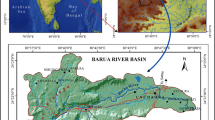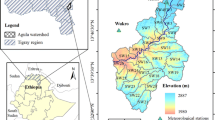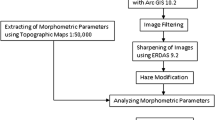Abstract
A drainage basin morphometric analysis has been carried out for the trans-boundary Duduya watershed located in the marginal parts of the Eastern Himalaya and its foreland of Bhutan and India. The linear, areal and relief morphometric parameters have been estimated based on topographical maps and SRTM DEM data. It is found that the Duduya is a 6th order drainage basin with asymmetric drainage arrangements with a total stream length of 1208.19 km. Almost all of the eleven sub-watersheds of the Duduya are elongated in nature and are characterized by medium drainage related parameters, e.g., density, frequency and texture signifying moderate flood susceptibilities while the presence of permeable soils, good vegetation cover facilitated considerable infiltration and water storage implying good groundwater potentials. The skewed distribution of relief parameters specially total relief, relief ratio and slope are indicators of erosion potential, however, this erosion potential is balanced by the elongated shape of the individual sub-watersheds and medium drainage related parameters. The region receives very high annual rainfall, besides majority of the watershed area is featured with very gentle slopes and flat terrains and therefore has prolonged runoff disposal meaning increased chances of floods in the downstream reaches. Several of the computed morphometric parameters were observed to have varied statistical associations and some of them are impacting each other significantly. A hierarchical cluster analysis suggested two different clusters of sub-watersheds, where SW1 and SW3 of the Eastern Himalayas need proper management for environmental issues like flash flood, channel avulsion and erosion due to high reliefs and moderate slopes, the rest of the sub-watersheds that are draining the lower parts of piedmont and the low-lying southern plain provide ideal conditions for cultivation due to flat terrains, meager slopes, greater infiltration and water storage capacities.
Similar content being viewed by others
References
Abdeta, G.C., Tesemma, A.B., Tura, A.L. and Atlabachew, G.H. (2020) Morphometric analysis for prioritizing sub watersheds and management planning and practices in Gidabo Basin, Southern Rift Valley of Ethiopia. Appl. Water Sci., v.10, 158. doi:https://doi.org/10.1007/s13201-020-01239-7.
Aher, P.D., Adinarayana, J. and Gorantiwar, S.D. (2014) Quantification of morphometric characterization and prioritization for management planning in semi-arid tropics of India: A remote sensing and GIS approach. Jour. Hydrol., v.511, pp.850–860.
Ansari, Z.R., Rao, L.A.K. and Yusuf, A. (2012) GIS based morphometric analysis of Yamuna drainage network in parts of Fatehabad area of Agra district, Uttar Pradesh. Jour. Geol. Soc. India, v.79, pp.505–514.
Baillie, I.C. and Norbu, C. (2004). Climate and other factors in the development of river and interfluve profiles in Bhutan, Eastern Himalayas. Jour. Asian Earth Sci., v.22, pp.539–553.
Bali, R., Agarwal, K.K., Ali, S.N., Rastogi, S.K. and Krishna, K. (2012) Drainage morphometry of Himalayan Glacio-fluvial basin, India: hydrologic and neotectonic implications. Environ. Earth Sci., v.66, pp.1163–1174.
Basu, T. and Pal, S. (2019) RS-GIS based morphometrical and geological multi-criteria approach to the landslide susceptibility mapping in Gish River Basin, West Bengal, India. Advan. Space Res., v.63(3), pp.1253–1269.
Bhat, M.S., Alam, A., Ahmad, S., Farooq, H. and Ahmad, B. (2019) Flood hazard assessment of upper Jhelum basin using morphometric parameters. Environ. Earth Sci., v.78, 54. doi:https://doi.org/10.1007/s12665-019-8046-1.
Biswas, A., Das Majumdar, D. and Banerjee, S. (2014) Morphometry governs the dynamics of a drainage basin: analysis and implications. Geography Jour. doi:https://doi.org/10.1155/2014/927176
Boruah, B., Dalabehera, L., Singh, M., Sarkar, B., Anju, V.R. and Gupta, G. (2013). Report on creation of theme based database of degree sheet no. 78F, (pp. 76). Kolkata: Geological Survey of India.
Chakraborty, S. and Dutta, K. (2013) Causes and consequences of channel Changes- a spatio-temporal analysis using remote sensing and GIS-Jaldhaka-Diana river system (lower course), Jalpaiguri (Duars), West Bengal, India. Jour. Geograp. Natural Disaster, v.3, pp.107. doi: https://doi.org/10.4172/2167-0587.1000107
Chauhan, P., Chauniyal, D.D., Singh, S. and Tiwari, R.K. (2016) Quantitative geo-morphometric and land cover-based micro watershed prioritization in the Tons river basin of the lesser Himalaya. Environ. Earth Sci., v.75, 498. doi:https://doi.org/10.1007/s12665-016-5342-x.
Clarke, C. (1966) Morphometry from map, essay in geomorphology. New York: Elsevier, pp. 235–274.
Faniran, A. (1968). The index of Drainage Intensity — A provisional new drainage factor. Australian Jour. Sci., v.31, pp.328–330.
Gansser, A. (1983) Geology of the Bhutan Himalaya. Boston: Birkhauser Verlag, pp.181.
Guha, D., Bardhan, S., Basir, S.R., De, A.K. and Sarkar, A. (2007) Imprints of Himalayan thrust tectonic on the Quaternary sediments of the Neora-Jaldhaka valley, Darjeeling Sikkim sub-Himalayas, India. Jour. Asian Earth Sci., v.30, pp.464–473.
Goswami, D.C. (1998) Fluvial regime and flood hydrology of the Brahmaputra river, Assam. In: V.S. Kale (Ed.), Flood studies in India, Mem. Geol. Soc. India, no.41, pp.53–76.
Hajam, R.A., Hamid, A. and Bhat, S. (2013). Application of morphometric analysis for geo-hydrological studies using geo-spatial technology — a case study of Vishav drainage basin. Hydrol. Curr. Res., v.4(3), 157. doi:https://doi.org/10.4172/2157-7587.1000157.
Hazbavi, Z. and Sadhegi, S.H.R. (2017) Watershed health characterization using reliability-resilience vulnerability conceptual framework based on hydrological responses. Land Degradation and Development, v.28, pp.1528–1537.
Horton, R.E. (1932) Drainage basin characteristics. Trans. Amer. Geophys. Union, v.13, pp.350–361.
Horton, R.E. (1945) Erosional development of streams and their drainage basins: hydrophysical approach to quantitative morphology. Geol. Soc. Amer. Bull., v.5, pp.275–370.
Howard, A.D. (1990). Role of hypsometry and planform in basin hydrologic response. Hydrol. Proces., v.4, pp.373–385.
Jain, A.O., Thaker, T.P., Misra, A.K., Singh, A.K. and Kumari, P. (2021). Determination of sensitivity of drainage morphometry towards hydrological response interactions for various datasets. Environ. Develop. Sustain., v.23, pp.1799–1822.
Jana, P. and Bardhan, S. (2010) Active fault studies in parts of piedmont belt in Nagrakata- Rajabhatkhawa sector, Jalpaiguri and Coochbehar district, West Bengal. Rec. Geol. Surv. India, (Eastern Region), v.142(3), pp.2–6.
Javed, A., Khanday, M.Y. and Rais, S. (2011) Watershed prioritization using morphometric and land use/land cover parameters: a remote sensing and GIS based approach. Jour. Geol. Soc. India, v.78, pp.63–75.
Kabite, G. and Gessesse, B. (2018) Hydro-geomorphological characterization of Dhidhessa river basin, Ethiopia. Internat. Soil Water Conserv. Res., v.6, pp.175–183.
Karmokar, S. and De, M. (2020) Flash food risk assessment for drainage basins in the Himalayan foreland of Jalpaiguri and Darjeeling districts, West Bengal. Modeling Earth Systems and Environment. doi:https://doi.org/10.1007/s40808-020-00807-9.
Khan, I., Bali, R., Agarwal, K.K., Kumar, D. and Singh, S.K. (2021). Morphometric analysis of Parvati basin, NW Himalaya: A remote sensing and GIS based approach. Jour. Geol. Soc. India, v.97, pp.165–172.
Kohn, H.F. and Hubert, L.J. (2015) Hierarchical cluster analysis. Wiley Statistics Reference Online. doi:https://doi.org/10.1002/9781118445112.stat02449.pub2.
Kumar, D., Singh, D.S., Prajapati, S.K., Khan, I., Gautam, P.K., and Vishawakarma, B. (2018) Morphometric parameters and neotectonics of Kalyani river basin, Ganga Plain: a remote sensing and GIS approach. Jour. Geol. Soc. India, v.91, pp.679–686.
Kumar, R., Suresh, N., Sangode, S.J., and Kumaravel, V. (2007) Evolution of the Quaternary alluvial fan system in the Himalayan foreland basin: Implications for tectonic and climatic decoupling. Quaternary Internat., v.159, pp.6–20.
Lanckriet, S., Derudder, B., Naudts, J., Bauer, H., Deckers, J., Haile, M. and Nyssen, J. (2014) A political ecology perspective of land degradation in the north Ethiopian highlands. Land Degradation and Development, v.26, pp.521–530.
Long, S., McQuarrie, N., Tobgay, T., Grujic, D. and Hollister, L. (2011). Geologic Map of Bhutan. Jour. Maps, v.7(1), pp.184–192.
Malik, A., Kumar, A., Kushwaha, D.P., Kisi, O., Salih, S.Q., Al-Ansari, N. and Yaseen, Z.M. (2019) The implementation of a hybrid model for hilly sub-watershed prioritization using morphometric variables: case study in India. Water, v.11, pp.1138.
Mesa, M.L. (2006) Morphometric analysis of a subtropical Andean basin (Tucuman, Argentina). Environ. Geol., v.50, pp.1235–1242.
Meshram, S.G. and Sharma, S.K. (2017) Prioritization of watershed through morphometric parameters: a PCA-based approach. Appl. Water Sci., v.7, 1505.
Miller, V.C. (1953) A quantitative geomorphic study of drainage basin characteristics in the Clinch mountain area, Virginia and Tennessee. Columbia University, Department of Geology, Technical Report, No. 3, Contract N6 ONR. 271–300.
Mooi, E., & Sarstedt, M. (2011) A Concise Guide to Market Research. Berlin Heidelberg: Springer-Verlag. https://doi.org/10.1007/978-3-642-12541-6_9.
Nakata, T. (1972) Geomorphic history and crustal movements of the foot-hills of the Himalayas. The Scientific Reports of the Tohoku University, VII Series, Geography, v.22(1), pp.39–177.
Nilsson, C., Reidy, C.A., Dynesius, M. and Revenga, C. (2005) Fragmentation and flow regulation of the world’s large river systems. Science, v.308, pp.405–408.
Pant, N., Dubey, R.K., Bhatt, A., Rai, S.P., Semwal, P., & Mishra, S. (2020) Soil erosion and flood hazard zonation using morphometric parameters in Upper Alaknanda river basin. Natural Hazards, v.103, pp.3263–3301.
Pike, R.J. and Wilson, S.E. (1971) Elevation-relief ratio, hypsometric integral and geomorphic area-altitude analysis. Geol. Soc. Amer. Bull., v.82, pp.1079–1084.
Prokop, P. (2018) Tea plantations as a driving force of long-term land use and population changes in the Eastern Himalayan piedmont. Land Use Policy, v.77, pp.51–62.
Reddy, V.R., Saharawat, Y.S. and George, B. (2017) Watershed management in South Asia: A synoptic review. Jour. Hydrol., v.551, pp.4–13.
Romshoo, S.A., Bhat, S.A. and Rashid, I. (2012) Geoinformatics for assessing the morphometric control on hydrological response at watershed scale in the Upper Indus basin. Jour. Earth Syst. Sci., v.121(3), pp.659–686.
Sah, R.K. and Das, A.K. (2016) Actualizing the role of morphometry in riverine hazards in an Eastern Himalayan river. Arabian Jour. Geosci., v.9, pp.211.
Schumm, S.A. (1956) The evolution of drainage systems and slopes in badlands at Perth Amboy, New Jersey. Geol. Soc. Amer. Bull., v.67, pp.597–646.
Sindhu, D., Sadashivappa., Ravikumar, A.S. and Shivakumar, B.L. (2015) Quantitative analysis of catchment using remote sensing and geographic information system. Aquatic Procedia, v.4, pp.1421–1428.
Singh, A.P., Arya, A.K. and Singh, D.S. (2020) Morphometric analysis of Ghaghara river basin, India, using SRTM data and GIS. Jour. Geol. Soc. India, v.95, pp.169–178.
Singh, O., Sarangi, A. and Sharma, M.C. (2008) Hypsometric integral estimation methods and its relevance on erosion status of North-Western Lesser Himalayan watersheds. Water Resour. Managmt., v.22, pp.1545–156.
Singh, P., Gupta, A. and Singh, M. (2014). Hydrological inferences from watershed analysis for water resource management using remote sensing and GIS techniques. Egyptian Jour. Remote Sens. Space Sci., v.17, pp.111–121.
Singh, S. and Dubey, A. (1994) Geo-environmental planning of watersheds in India. Allahabad: Chugh Publications, pp. 28–69.
Smith, K.G. (1950). Standards for grading textures of erosional topography. Amer. Jour. Sci., v.248, pp.655–668.
Sreedevi, P.D., Owais, S., Khan, H.H. and Ahmed, S. (2009) Morphometric analysis of a watershed of South India using SRTM data and GIS. Jour. Geol. Soc. India, v.73, pp.543–552.
Sreedevi, P.D., Sreekanth, P.D., Khan, H.H. and Ahmed, S. (2013) Drainage morphometry and its influence on hydrology in an semi arid region: using SRTM data and GIS. Environ. Earth Sci., v.70(2), pp.839–848.
Soja, R. and Starkel, L. (2007) Extreme rainfalls in Eastern Himalaya and southern slope of Meghalaya plateau and their geomorphologic impacts. Geomorphology, v.84, pp.170–180.
Starkel, L., Sarkar, S., Soja, R. and Prokop, P. (2008) Present-day evolution of the Sikkimese-Bhutanese Himalayan piedmont. Prace Geografczne, IGiPZ PAN: 219.
Strahler, A.N. (1957) Quantitative analysis of watershed geomorphology. Trans. Amer. Geophys. Union, v.38, pp.913–920.
Strahler, A.N. (1964) Quantitative geomorphology of drainage basin and channel networks. In: V.T. Chow (Ed), Handbook of applied hydrology. New York: McGraw Hill Book, pp. 4–76.
Sutradhar, H. (2020) Assessment of drainage morphometry and watersheds prioritization of Siddheswari river basin, Eastern India. Jour. Indian Soc. Remote Sens., v.48, pp.627–644.
Thompson, J.R., Taylor, M.P., Fryirs, K.A. and Brierley, G.J. (2001) A geomorphological frame work for river characterization and habitat assessment. Aquatic Conservation: Marine Freshwater Ecosystems, v.11, pp.373–389.
Tripathi, M.P., Panda, R.K., and Raghuwanshi, N.S. (2003) Identification and prioritisation of critical sub-watersheds for soil conservation management using the SWAT model. Biosystems Engg., v.85(3), pp.365–379.
Yang, G., Chen, Z. and Jiang, J. (2020) Drainage morphometry of the Lishui catchment in the Middle Yangtze basin, China: morphologic and tectonic implications. Arabian Jour. Geosci., v.13, 561. doi:https://doi.org/10.1007/s12517-020-05481-w.
Author information
Authors and Affiliations
Corresponding author
Rights and permissions
About this article
Cite this article
Chakraborty, S. Application of Basin Morphometry for Hydro-geomorphological Implications: A Study of the Indo-Bhutanese Duduya Watershed. J Geol Soc India 99, 473–486 (2023). https://doi.org/10.1007/s12594-023-2335-8
Received:
Accepted:
Published:
Issue Date:
DOI: https://doi.org/10.1007/s12594-023-2335-8




